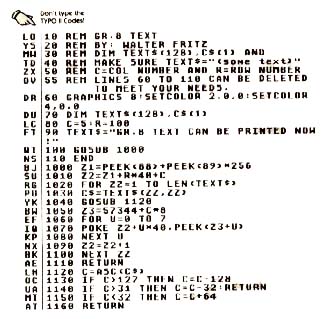TECH TIPS
Which DOS?
By Donald Seay
Sometimes it can be helpful to know which DOS you booted with. With one or two PEEKs from BASIC you can easily find out. Use this table to determine the DOS version:
PEEK( ) Value DOS Version
Returned
3889 0 SpartaDOS 2.3e
13 DOS 4.0
15 SpartaDOS 1.1
19 Atari DOS 2.5
76 Atari DOS 3.0
78 Atari DOS 3.0
89 SpartaDOS 3.2d
108 MYDOS 4.0
207 OSS OS/A+ 4.00
221 MYDOS 4.50
238 OSS DOS XL 2.3
244 Atari DOS XE
1804 0 OSS DOS XL 2.3
124 Atari DOS 2.0s
Just type PRINT PEEK(3889) [RETURN] at the READY prompt in BASIC, and compare the number printed on your screen with this chart. Note that Atari DOS 3.0 may return either a value of 76 or 78 at location 3889. Both Atari DOS 2.OS and OSS DOS XL 2.3 show a value of 238 at location 3889. To distinguish between the two, check location 1804.
Text in Graphics 8 Mode
By Walter Fritz
Printing text on the screen in Graphics 8 mode is sometimes difficult to achieve. While Atari BASIC does not have an immediate function to put text on the graphics screen, BASIC can be coaxed to write text to the screen by using POKE commands.
This subroutine by Watler Fritz of Glendale, Wisconsin can be put into your programs that need to write text on the Graphics 8 screen. The only thing you must keep in mind is to DIMension TEXT$ to 128, or to whatever number you need for your program's purposes. Also DIMension 'C$' to 1. To use this subroutine just GOSUB to line 1000, then use TEXT$ to define the text that you want to write to the screen. (You can also print the special character set to screen.)
The text can be placed anywhere on the screen by putting in values for C and R, respectively the Column and Row where the text should start. When C=0 and R=0 the text would start in the upper left corner. C=20 and R=100 would start the text in the center. Lastly, if C=39 and R=150 then the text goes in the lower right corner.

Installing DOS
By Eric anderson Eric
To put DOS on a non-DOS disk from BASIC, simply open a file called DOS.SYS for output, and then close it. The DOS you booted with will be written to the disk, and you can now boot with that disk. You won't be able to get a DOS menu from it -- that part of the operating system is contained in the file DUP.SYS, which must be copied separately.
The following commands to install DOS on drive 1 work with Atari DOS 2.0 and 2.5 and MYDOS, and quite possibly with other operating systems too:
100 OPEN #l,8,0,"D1:DOS.SYS"
110 CLOSE #1